The Impact of Distinct Superplasticizers on the Degradation of Concrete Affected by Alkali-Silica Reaction (ASR)
Abstract
:1. Introduction
2. Background
2.1. Alkali-Silica Reaction (ASR) in Concrete
2.2. The Use of Superplasticizers in Concrete
2.3. Tools for Assessing Concrete Damaged by ASR
2.3.1. Stiffness Damage Test (SDT)
2.3.2. Damage Rating Index (DRI)
3. Scope of Work
4. Material and Methods
4.1. Materials and Mixture Proportions
4.2. Fabrication of Concrete Specimens
4.3. Experimental Procedures
4.3.1. Stiffness Damage Test (SDT)
4.3.2. Damage Rating Index (DRI)
5. Results
5.1. The Development of ASR Damage through Expansion
5.2. Mechanical Damage via the Stiffness Damage Test (SDT)
5.3. Microscopic Analysis via the Damage Rating Index (DRI)
6. Discussion
6.1. The Impact of Distinct Superplasticizers on ASR Damage in Concrete
6.1.1. Expansion and Kinetics
6.1.2. Measuring Deterioration
- Microscopic Assessment
- Mechanical Property Losses
- Summary
6.2. Validation of the Impact of SPs on ASR-Induced Deterioration
7. Conclusions
- The concrete specimens that incorporated Admixture 2 (i.e., 4.1% of Na2Oeq) demonstrated faster ASR-induced expansion, while those made with Admixture 1 (i.e., 0.00009% of Na2Oeq) displayed slower ASR kinetics when compared to the conventional concrete samples. This is likely due to the chemical composition (i.e., alkali content) of the incorporated superplasticizers; the higher the alkali content of the SP used in the mixture, the higher the alkalinity of the pore solution, likely resulting in higher ASR kinetics;
- Similar to expansion behavior, the Admixtures 2 and 1 concrete specimens displayed greater and lesser ASR damage development, respectively. This clearly attests to the effect of alkali content (in distinct SPs) on the development of ASR-induced damage; the higher the alkali content of the SP used in the concrete mixture, the higher the ASR development. Moreover, very low alkali content in an SP used in a concrete mixture can act as a mitigation strategy against ASR development. Nevertheless, the multilevel assessment used in this study proved to be a suitable diagnostic approach that is able to capture the differences in the damage induced by ASR;
- An investigation into the chemical composition of the ASR gel found in the aggregate particles of the distinct concrete specimens showed that the specimens manufactured with Admixture 2 had the highest Na and Ca content, while those incorporating Admixture 1 had the lowest Na and Ca content. This could be a clear sign that the ASR gel analyzed in the aggregate particles of the specimens made with Admixture 2 had the highest ASR deterioration potential. Likewise, the significantly higher Ca content in the ASR gel obtained from the cement paste of the Admix 2 concrete specimens, once again, attests to the higher risk of ASR damage when using the Admixture 2 samples;
- A comparison of the distinct atomic ratios of the various ASR gels (i.e., Na/Si and Ca/Si) gathered from the aggregate particles of the distinct concrete specimens showed that those made with Admixture 2 had the highest Na/Si and Ca/Si ratios, while those incorporating Admixture 1 had the lowest Na/Si and Ca/Si ratios. According to the previous works, this observation clearly attests to the mitigation potential of SP admixtures with very low alkali content against ASR deterioration, while those superplasticizers with high alkali content increase the likelihood of ASR damage.
Author Contributions
Funding
Institutional Review Board Statement
Informed Consent Statement
Data Availability Statement
Acknowledgments
Conflicts of Interest
References
- Xun, W.; Wu, C.; Leng, X.; Li, J.; Xin, D.; Li, Y. Effect of Functional Superplasticizers on Concrete Strength and Pore Structure. Appl. Sci. 2020, 10, 3496. [Google Scholar] [CrossRef]
- Wu, R.D.; Dai, S.B.; Jian, S.W.; Huang, J.; Lv, Y.; Li, B.D.; Azizbek, N. Utilization of the circulating fluidized bed combustion ash in autoclaved aerated concrete: Effect of superplasticizer. Constr. Build. Mater. 2019, 237, 117644. [Google Scholar] [CrossRef]
- Diamond, S. The patch microstructure in concrete: The effect of superplasticizer. Cem. Concr. Res. 2006, 36, 776–779. [Google Scholar] [CrossRef]
- Saouma, V.E. Diagnosis & Prognosis of AAR Affected Structures; State-of-the-Art Report of the RILEM Technical Committee 259-ISR; Springer Nature: Basel, Switzerland, 2021. [Google Scholar]
- Noël, M.; Sanchez, L.; Martin, R.; Fournier, B.; Bastien, J. Structural Implications of Internal Swelling Reactions in Concrete: A Review. In Proceedings of the 15th International Conference on Alkali Aggregate Reaction, Sao Paulo, Brazil, 3–7 July 2016. [Google Scholar]
- Sanchez, L.; Fournier, B.; Jolin, M.; Mitchell, D.; Bastien, J. Overall assessment of Alkali-Aggregate Reaction (AAR) in concretes presenting different strengths and incorporating a wide range of reactive aggregate types and natures. Cem. Concr. Res. 2017, 93, 17–31. [Google Scholar] [CrossRef]
- Sanchez, L.F.M.; Drimalas, T.; Fournier, B.; Mitchell, D.; Bastien, J. Comprehensive damage assessment in concrete affected by different internal swelling reaction (ISR) mechanisms. Cem. Concr. Res. 2018, 107, 284–303. [Google Scholar] [CrossRef]
- Sanchez, L.; Fournier, B.; Mitchell, D.; Bastien, J. Condition assessment of an ASR-affected overpass after nearly 50 years in service. Constr. Build. Mater. 2019, 236, 117554. [Google Scholar] [CrossRef]
- Fournier, B.; Bérubé, M.-A. Alkali-aggregate reaction in concrete: A review of basic concepts and engineering implications. Can. J. Civ. Eng. 2000, 27, 167–191. [Google Scholar] [CrossRef]
- Rajabipour, F.; Giannini, E.; Dunant, C.; Ideker, J.H.; Thomas, M.D.A. Alkali–silica reaction: Current understanding of the reaction mechanisms and the knowledge gaps. Cem. Concr. Res. 2015, 76, 130–146. [Google Scholar] [CrossRef]
- Kaladharan, G.; Szeles, T.; Stoffels, S.M.; Rajabipour, F. Novel admixtures for mitigation of alkali-silica reaction in concrete. Cem. Concr. Compos. 2021, 120, 104028. [Google Scholar] [CrossRef]
- Zahedi, A.; Trottier, C.; Sanchez, L.F.; Noël, M. Microscopic assessment of ASR-affected concrete under confinement conditions. Cem. Concr. Res. 2021, 145, 106456. [Google Scholar] [CrossRef]
- Sims, I.; Poole, A. Alklai Aggregate Reaction in Concrete, A World Review; Taylor & Francis Group: London, UK, 2017. [Google Scholar]
- Allard, A.; Bilodeau, S.; Pissot, F.; Fournier, B.; Bastien, J.; Bissonnette, B. Expansive behavior of thick concrete slabs affected by alkali-silica reaction (ASR). Constr. Build. Mater. 2018, 171, 421–436. [Google Scholar] [CrossRef]
- Thomas, M.D.A.; Folliard, K.J.; Fournier, B.; Rivard, P.; Drimalas, T. Methods for Evaluating and Treating ASR-Affected Structures: Results of Field Application and Demonstration Projects—Volume II: Details of Field Applications and Analysis; Federal Highway Administration: Washington, DC, USA, 2013.
- Thomas, M.D.A.; Ideker, J. North America (USA and Canada). In Alkali-Aggregate Reaction in Concrete. A World Review, 1st ed.; Sims, I., Poole, A., Eds.; CRC Press: Boca Raton, FL, USA, 2017. [Google Scholar]
- Bérubé, M.-A.; Fournier, B.; Durand, B.; Vézina, D. Alkali-aggregate reactivity in Québec (Canada). Can. J. Civ. Eng. 2000, 27, 226–245. [Google Scholar] [CrossRef]
- Rogers, C.; Hooton, R.D.; Ryell, J.; Thomas, M.D.A. Alkali-Aggregate reactions in Ontario. Can. J. Civ. Eng. 2000, 27, 246–260. [Google Scholar] [CrossRef]
- Gautam, B.P.; Panesar, D.K.; Sheikh, S.A.; Vecchio, F.J.; Orbovic, N. Alkali Aggregate Reaction in Nuclear Concrete Structures: Part 2: Concrete Materials Aspects; SMiRT 23: Manchester, UK, 2015. [Google Scholar]
- Fournier, B.; Bérubé, A.; Folliard, J.; Thomas, M. Report on the Diagnosis, Prognosis, and Mitigation of Alkali-Silica Reaction (ASR) in Transportation Structures; Report No. FHWA-HIF-09-004, Federal Highway Administration; U.S. Department of Transportation: Washington, DC, USA, 2010.
- Thomas, M. The effect of supplementary cementing materials on alkali-silica reaction: A review. Cem. Concr. Res. 2011, 41, 1224–1231. [Google Scholar] [CrossRef]
- Thomas, M.; Folliard, K.; Fournier, B.; Rivard, P.; Drimalas, T. Methods for Evaluating and Treating ASR-Affected Structures: Results of Field Application and Demonstration Projects I; Report No. FHWA-HIF-14-0002; Federal Highway Administration, U.S. Department of Transportation: Washington, DC, USA, 2013.
- Diamond, S. Unique response of LiNO3 as an alkali silica reaction-preventive admixture. Cem. Concr. Res. 1999, 29, 1271–1275. [Google Scholar] [CrossRef]
- Tosun, K.; Felekoğlu, B.; Baradan, B. The effect of cement alkali content on ASR susceptibility of mortars incorporating admixtures. Build. Environ. 2007, 42, 3444–3453. [Google Scholar] [CrossRef]
- Guo, S.; Dai, Q.; Si, R. Effect of calcium and lithium on alkali-silica reaction kinetics and phase development. Cem. Concr. Res. 2019, 115, 220–229. [Google Scholar] [CrossRef]
- Leemann, A.; Lörtscher, L.; Bernard, L.; Le Saout, G.; Lothenbach, B.; Espinosa-Marzal, R.M. Mitigation of ASR by the use of LiNO3—Characterization of the reaction products. Cem. Concr. Res. 2014, 59, 73–86. [Google Scholar] [CrossRef]
- Latham, E.; Kilbey, B. Lithium Supply Is Set to Triple by 2025. Will it Be Enough? Glob. S&P: 2019. Available online: https://www.spglobal.com/en/research-insights/articles/lithium-supply-is-set-to-triple-by-2025-will-it-be-enough (accessed on 8 April 2023).
- Manissero, C.; Stewart, R. Economics of lithium technology for ASR control vs. Alternatives. Concr. Focus. NRMCA 2006, 43–51. [Google Scholar]
- Farny, J.A.; Kerkhoff, B. Diagnosis and control of alkali-aggregate reactions in concrete. Portl. Cem. Assoc. 2007, pp. 1–24. Available online: http://www.cement.org/docs/default-source/fc_concrete_technology/is413-02---diagnosis-and-control-of-alkali-aggregate-reactions-in-concrete.pdf?sfvrsn=2 (accessed on 8 April 2023).
- Zahedi, A. The Preliminary Evaluation of the Susceptibility of Cyprus Aggregates to Alkali Aggregate Reaction. Master’s Thesis, Near East University, Nicosia, Cyprus, 2014. [Google Scholar]
- Forster, S.W.; Boone, R.L.; Hammer, M.S.; Lamond, J.F.; Lane, D.S.; Miller, R.E.; Parker, S.E.; Pergalsky, A.; Pierce, J.S.; Robert, M.Q.; et al. State-of-the-Art Report on Alkali-Aggregate Reactivity Reported by ACI Committee 221; American Concrete Institute: Farmington Hills, MI, USA, 1998; Volume 98, pp. 1–31. [Google Scholar]
- Flaviana, C.; Silva, C.; Silva, A.S.; Carneiro, A.M.P. Influence of superplasticizers admixtures in the alkali-silica reaction. In Proceedings of the 15th International Conference on Alkali-Aggregate Reaction, Sao Paulo, Brazil, 3–7 July 2016. [Google Scholar]
- Wieland, E.; Lothenbach, B.; Glaus, M.; Thoenen, T.; Schwyn, B. Influence of superplasticizers on the long-term properties of cement pastes and possible impact on radionuclide uptake in a cement-based repository for radioactive waste. Appl. Geochem. 2014, 49, 126–142. [Google Scholar] [CrossRef]
- Leemann, A.; Lothenbach, B.; Thalmann, C. Influence of superplasticizers on pore solution composition and on expansion of concrete due to alkali-silica reaction. Constr. Build. Mater. 2011, 25, 344–350. [Google Scholar] [CrossRef]
- Uchikawa, H.; Hanehara, S.; Sawaki, D. The role of steric repulsive force in the dispersion of cement particles in fresh paste prepared with organic admixture. Cem. Concr. Res. 1997, 27, 37–50. [Google Scholar] [CrossRef]
- Kim, B.; Jiang, S.; Aïtcin, P. Influence of molecular weight of PNS superplasticizers on the properties of cement pastes containing different alkali contents. In The Role of Admixtures in High Performance Concrete; Cabrera, J.G., Rivera-Villarreal, R., Eds.; RILEM: Champs-sur-Marne, France, 1999. [Google Scholar]
- Winnefeld, F.; Becker, S.; Pakusch, J.; Götz, T. Effects of the molecular architecture of comb-shaped superplasticizers on their performance in cementitious systems. Cem. Concr. Compos. 2007, 29, 251–262. [Google Scholar] [CrossRef]
- Esfahani, M.; Adineh, R. Alkali-silica reaction (ASR) in concrete (the effect of test type, cement type and admixtures of silica fume and superplasticizer). Amirkabir 2004, 15, 110–119. Available online: https://www.sid.ir/en/journal/ViewPaper.aspx?id=5072 (accessed on 8 April 2023).
- Gillott, J.E.; Wang, H. Improved control of alkali-silica reaction by combined use of admixtures. Cem. Concr. Res. 1993, 23, 973–980. [Google Scholar] [CrossRef]
- Ramachandran, V.S. Alkali-aggregate expansion inhibiting admixtures. Cem. Concr. Compos. 1998, 20, 149–161. [Google Scholar] [CrossRef]
- Fares, G.; Khan, M.I. The effect of curing time on the ASR expansion of different HPC composites. Constr. Build. Mater. 2014, 72, 124–132. [Google Scholar] [CrossRef]
- Wang, H.; Gillott, J. The effect of superplasticizers on alkali-silica reaction. In Proceedings of the 8th International Conference Alkali-Aggregate React, Kyoto, Japan, 17–20 July 1989; pp. 187–192. [Google Scholar]
- Carroll, S.A.; Maxwell, R.S.; Bourcier, W.; Martin, S.; Hulsey, S. Evaluation of silica-water surface chemistry using NMR spectroscopy. Geochim. Cosmochim. Acta 2002, 66, 913–926. [Google Scholar] [CrossRef]
- Sanchez, L.; Fournier, B.; Jolin, M.; Bastien, J. Evaluation of the Stiffness Damage Test (SDT) as a tool for assessing damage in concrete due to alkali-silica reaction (ASR): Input parameters and variability of the test responses. Constr. Build. Mater. 2015, 77, 20–32. [Google Scholar] [CrossRef]
- Sanchez, L.F.M.; Fournier, B.; Jolin, M.; Bastien, J.; Mitchell, D. Practical use of the Stiffness Damage Test (SDT) for assessing damage in concrete infrastructure affected by alkali-silica reaction. Constr. Build. Mater. 2016, 125, 1178–1188. [Google Scholar] [CrossRef]
- Crisp, T.M.; Wood, J.G.M.; Norris, P. Towards Quantification of Microstructural Damage in AAR Deteriorated Concrete. In Proceedings of the International Conference on Recent Developments on the Fracture of Concrete and Rock, Cardiff, UK, 20–22 September 1989; The University of Wales: Cardiff, UK, 1989; pp. 419–427. [Google Scholar]
- Chrisp, T.M.; Waldron, P.; Wood, J.G.M. Development of a non destructive test to quantity damage in deteriorated concrete. Mag. Concr. Res. 1993, 45, 247–256. [Google Scholar] [CrossRef]
- Dunbar, P.; Grattan-Bellew, P. Results of damage rating evaluation of condition of concrete from a number of structures affected by ASR. In Proceedings of the CANMET/ACI International Workshop on Alkali-Aggregate Reactions in Concrete, Darmouth, NS, Canada, 1–4 October 1995; pp. 257–266. [Google Scholar]
- Grattan-bellew, P.E. Laboratory Evaluation of Alkali-Silica Reaction in Concrete from Saunders Generating Station. Mater. J. 1995, 92, 126–134. [Google Scholar]
- Hooton, R.; Rivard, P.; Fournier, B.; Ballivy, G. The Damage Rating Index Method for ASR Affected Concrete—A Critical Review of Petrographic Features of Deterioration and Evaluation Criteria. Cem. Concr. Aggreg. 2002, 24, 11228. [Google Scholar] [CrossRef]
- Villeneuve, V.; Fournier, B. Determination of the damage in concrete affected by ASR—The damage rating index (DRI). In Proceedings of the 14th ICAAR-International Conference on Alkali-Aggregate Reaction in Concrete, Austin, TX, USA, 20–25 May 2012; pp. 1–10. [Google Scholar]
- Villeneuve, V. Détermination de L’endommagement du Béton Par Méthode Pétrographique Quantitative. Ph.D. Thesis, Department of Geology and Geological Engineering, Université Laval, Québec, QC, Canada, 2011. [Google Scholar]
- ASTM C1293; Standard Test Method for Determination of Length Change of Concrete Due to Alkali-Silica Reaction. ASTM INTERNATIONAL: West Conshohocken, PA, USA, 2015; pp. 1–7.
- Fournier, B.; Bilodeau, A.; Thomas, M.D.A.; Folliard, K. Uses of Class C fly ash in Ternary Blends for Mitigation of Alkali-Silica Reactivity; EPRI: Palo Alto, CA, USA, 2007. [Google Scholar]
- ASTM C1260-01; Test Method for Potential Alkali Reactivity of Aggregates (Mortar–Bar Method). ASTM INTERNATIONAL: West Conshohocken, PA, USA, 2002.
- ASTM C192; Standard Practice for Roads and Parking Lots Pavement Condition Index Surveys. ASTM INTERNATIONAL: West Conshohocken, PA, USA, 2007; pp. 1–8.
- Sanchez, L.; Fournier, B.; Jolin, M.; Bastien, J. Evaluation of the stiffness damage test (SDT) as a tool for assessing damage in concrete due to ASR: Test loading and output responses for concretes incorporating fine or coarse reactive aggregates. Cem. Concr. Res. 2014, 56, 213–229. [Google Scholar] [CrossRef]
- ASTM C39; Standard Test Method for Compressive Strength of Cylindrical Concrete Specimens. ASTM INTERNATIONAL: West Conshohocken, PA, USA, 2012.
- ASTM C1074-19; Standard Practice for Estimating Concrete Strength by the Maturity Method. ASTM INTERNATIONAL: West Conshohocken, PA, USA, 2019.
- CSA23.2-14C; Obtaining and Testing Drilled Cores for Compressive Strength Testing. Canadian Standards Association: Toronto, ON, Canada, 2019; pp. 774–778.
- Zahedi, A.; Trottier, C.; Sanchez, L.F.M.; Noël, M. Condition assessment of alkali-silica reaction affected concrete under various confinement conditions incorporating fine and coarse reactive aggregates. Cem. Concr. Res. 2022, 153, 106694. [Google Scholar] [CrossRef]
- TR 30 Concrete Society. Alkali-Silica Reaction—Minimising the Risk of Damage to Concrete; Technical Report No. 30; The Concrete Society: London, UK, 1999. [Google Scholar]
- Bonen, D.; Sarkar, S.L. The superplasticizer adsorption capacity of cement pastes, pore solution composition, and parameters affecting flow loss. Cem. Concr. Res. 1995, 25, 1423–1434. [Google Scholar] [CrossRef]
- Sanchez, L.F.M.; Fournier, B.; Jolin, M.; Duchesne, J. Reliable quantification of AAR damage through assessment of the Damage Rating Index (DRI). Cem. Concr. Res. 2015, 67, 74–92. [Google Scholar] [CrossRef]
- Zahedi, A.; Trottier, C.; Sanchez, L.; Noël, M. Evaluation of the induced mechanical deterioration of alkali-silica reaction affected concrete under distinct confinement conditions through the Stiffness Damage Test. Cem. Concr. Compos. 2021, 126, 104343. [Google Scholar] [CrossRef]
- Zahedi, A.; De Souza, D.J.; Zubaida, N.; Sanchez, L.F. Overall assessment of CFRP-wrapped concrete affected by alkali-silica reaction. Cem. Concr. Res. 2023, 169, 107165. [Google Scholar] [CrossRef]
- Mindess, S.; Young, J.F.; Darwin, D. Concrete, 2nd ed.; Pearson Education Ltd.: London, UK, 2003. [Google Scholar]
- Leemann, A.; Lura, P. E-modulus of the alkali–silica-reaction product determined by micro-indentation. Constr. Build. Mater. 2013, 44, 221–227. [Google Scholar] [CrossRef]
- Beyene, M.; Snyder, A.; Lee, R.; Blaszkiewicz, M. Alkali Silica Reaction (ASR) as a root cause of distress in a concrete made from Alkali Carbonate Reaction (ACR) potentially susceptible aggregates. Cem. Concr. Res. 2013, 51, 85–95. [Google Scholar] [CrossRef]
- Zhang, C.; Sorelli, L.; Fournier, B.; Duchesne, J.; Bastien, J.; Chen, Z. Stress-relaxation of crystalline alkali-silica reaction products: Characterization by micro- and nanoindentation and simplified modeling. Constr. Build. Mater. 2017, 148, 455–464. [Google Scholar] [CrossRef]
- Ahmed, H.; Zahedi, A.; Sanchez, L.F.; Fecteau, P.-L. Condition assessment of ASR-affected reinforced concrete columns after nearly 20 years in service. Constr. Build. Mater. 2022, 347, 128570. [Google Scholar] [CrossRef]
- Leemann, A.; Shi, Z.; Lindgård, J. Characterization of amorphous and crystalline ASR products formed in concrete aggregates. Cem. Concr. Res. 2020, 137, 106190. [Google Scholar] [CrossRef]
- Sun, L.; Zhu, X.; Zhuang, X.; Zi, G. Chemo-Mechanical Model for the Expansion of Concrete Due to Alkali Silica Reaction. Appl. Sci. 2020, 10, 3807. [Google Scholar] [CrossRef]
- Gholizadeh-Vayghan, A.; Rajabipour, F. Quantifying the swelling properties of alkali-silica reaction (ASR) gels as a function of their composition. J. Am. Ceram. Soc. 2017, 100, 3801–3818. [Google Scholar] [CrossRef]

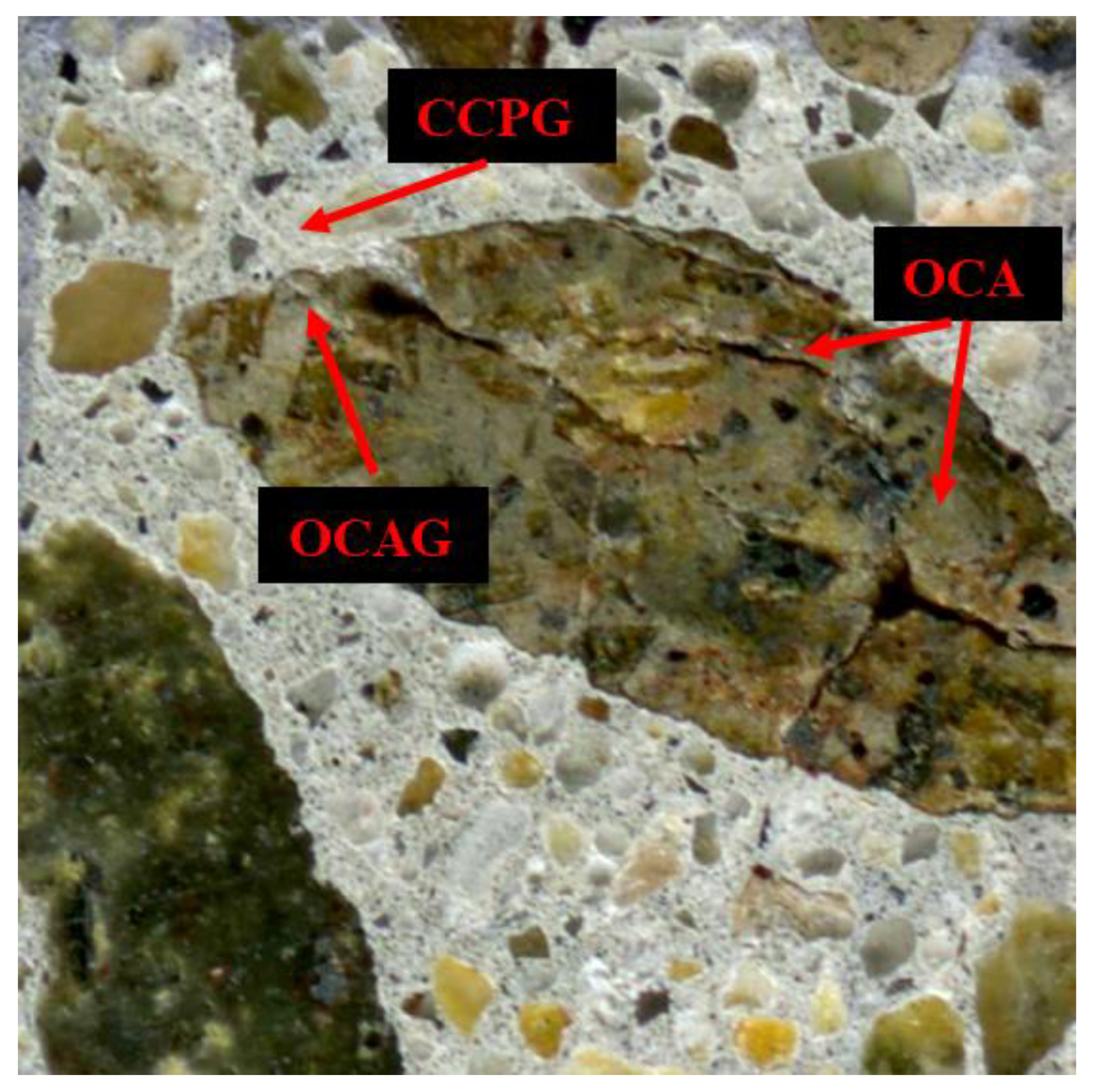

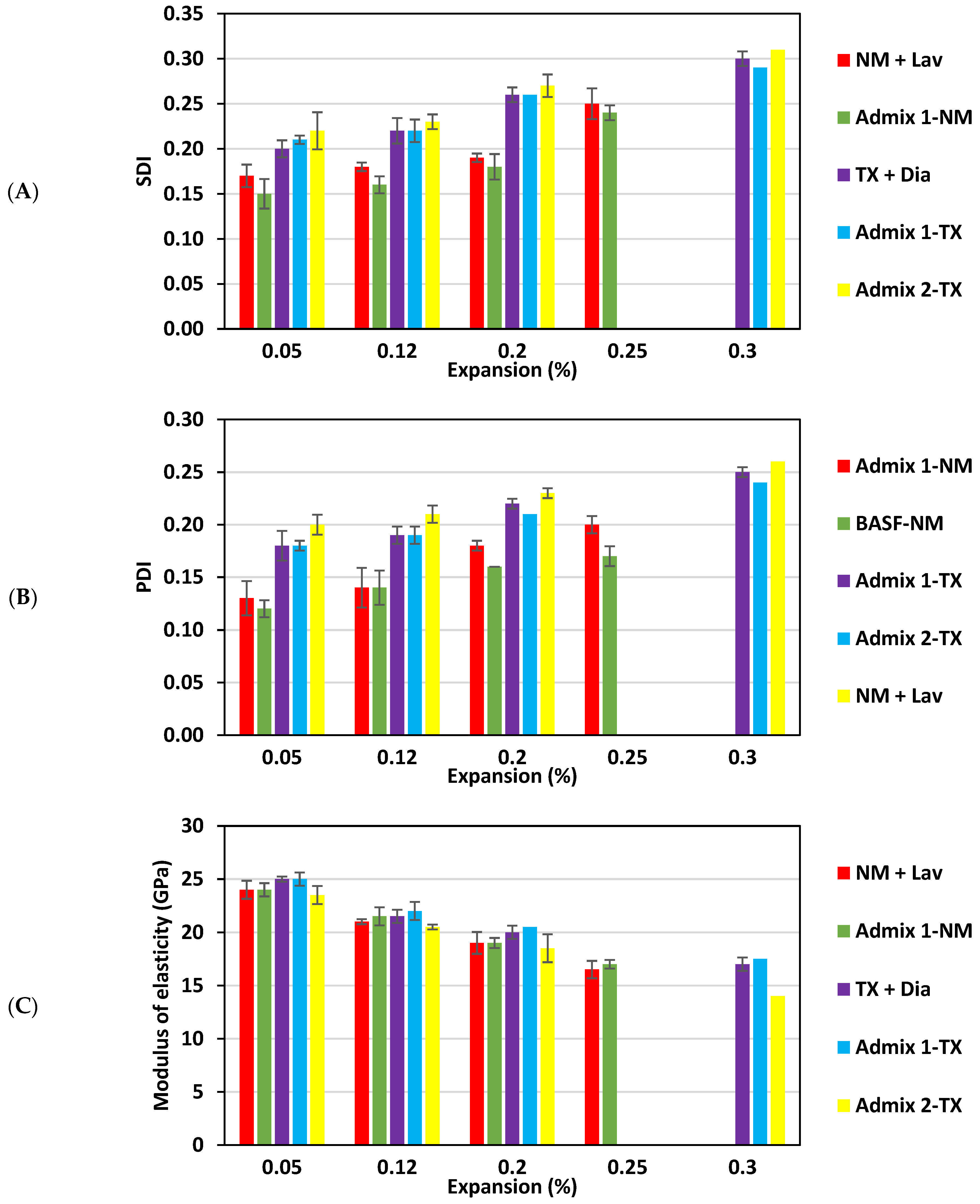



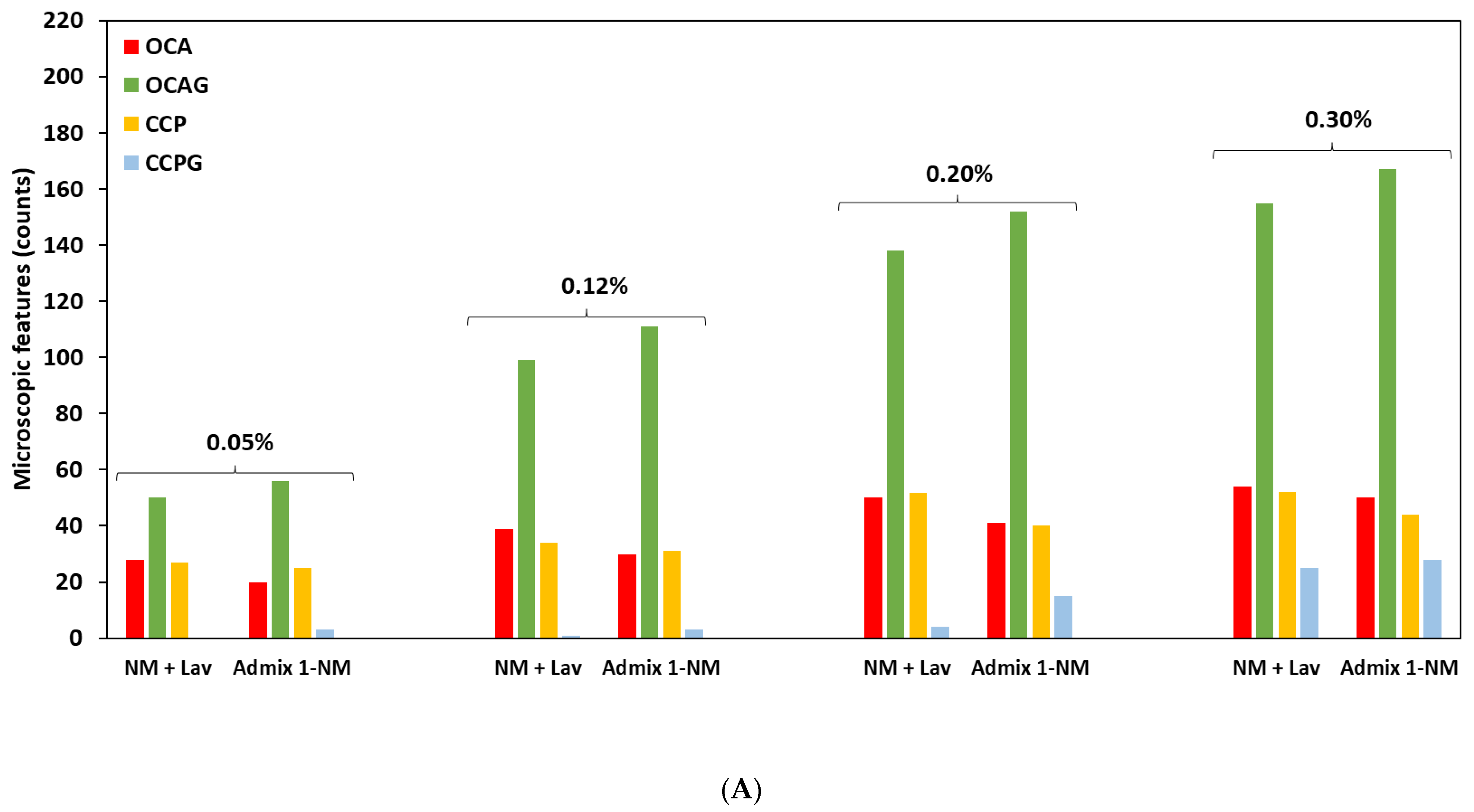

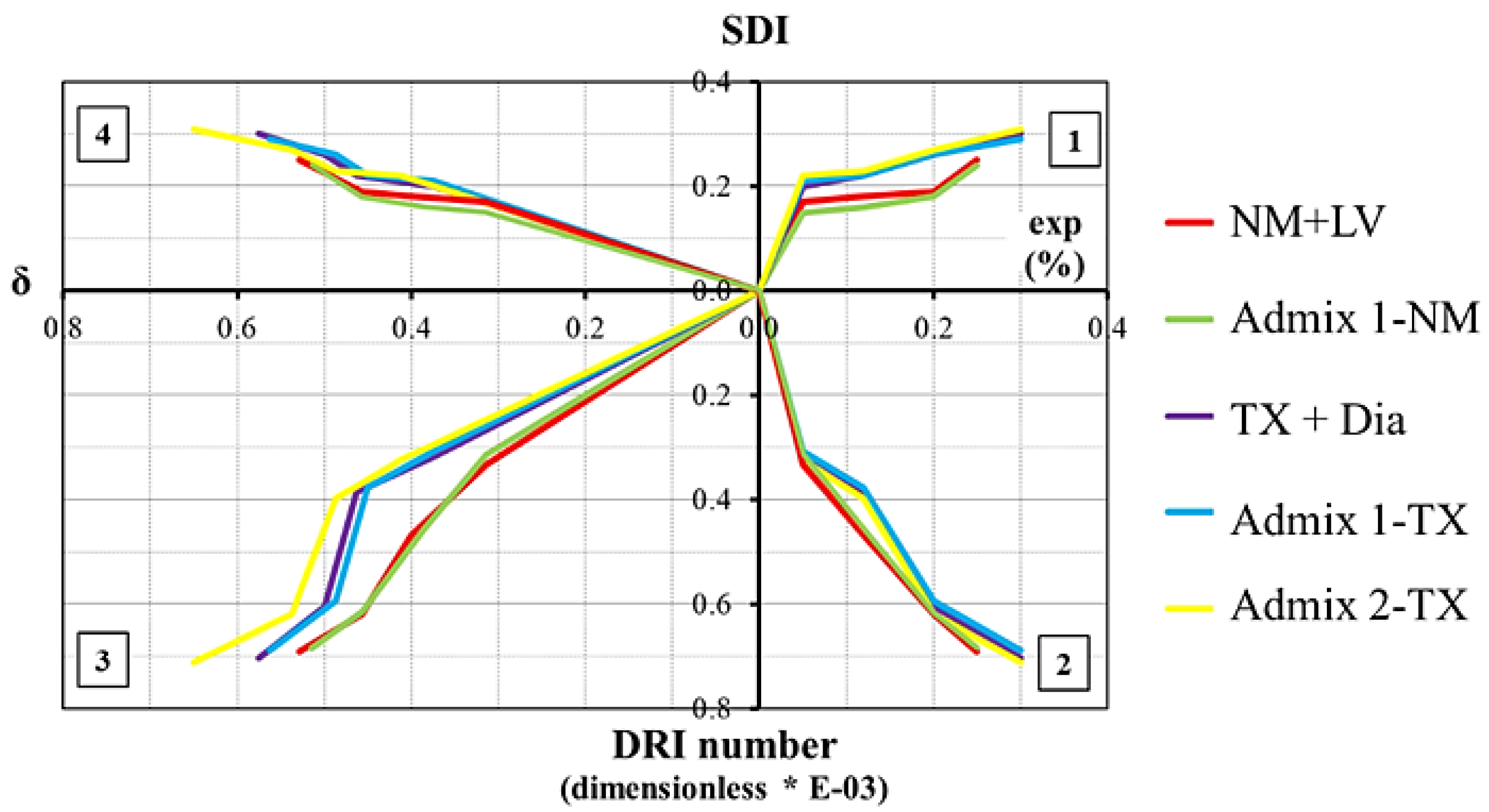
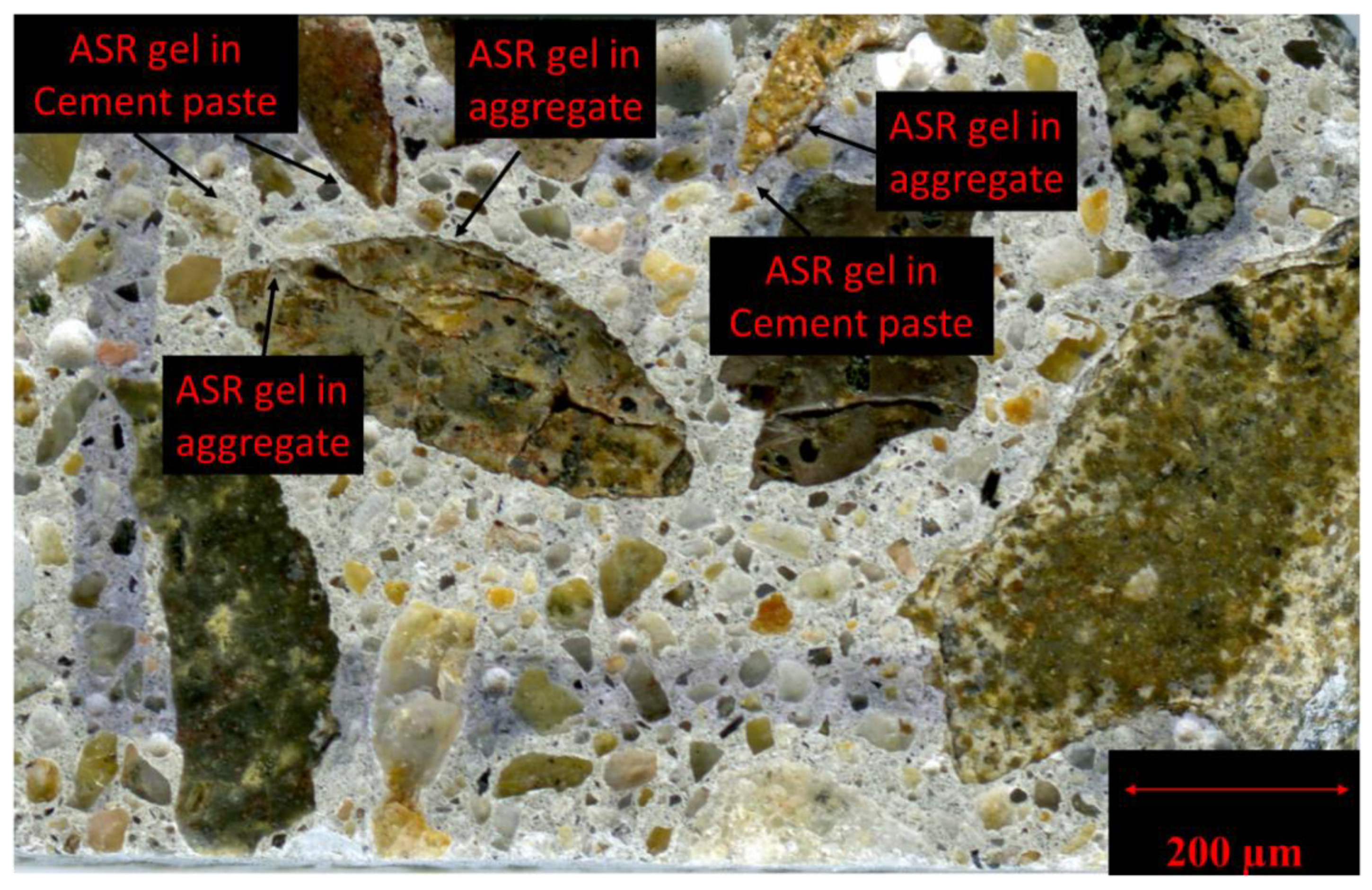
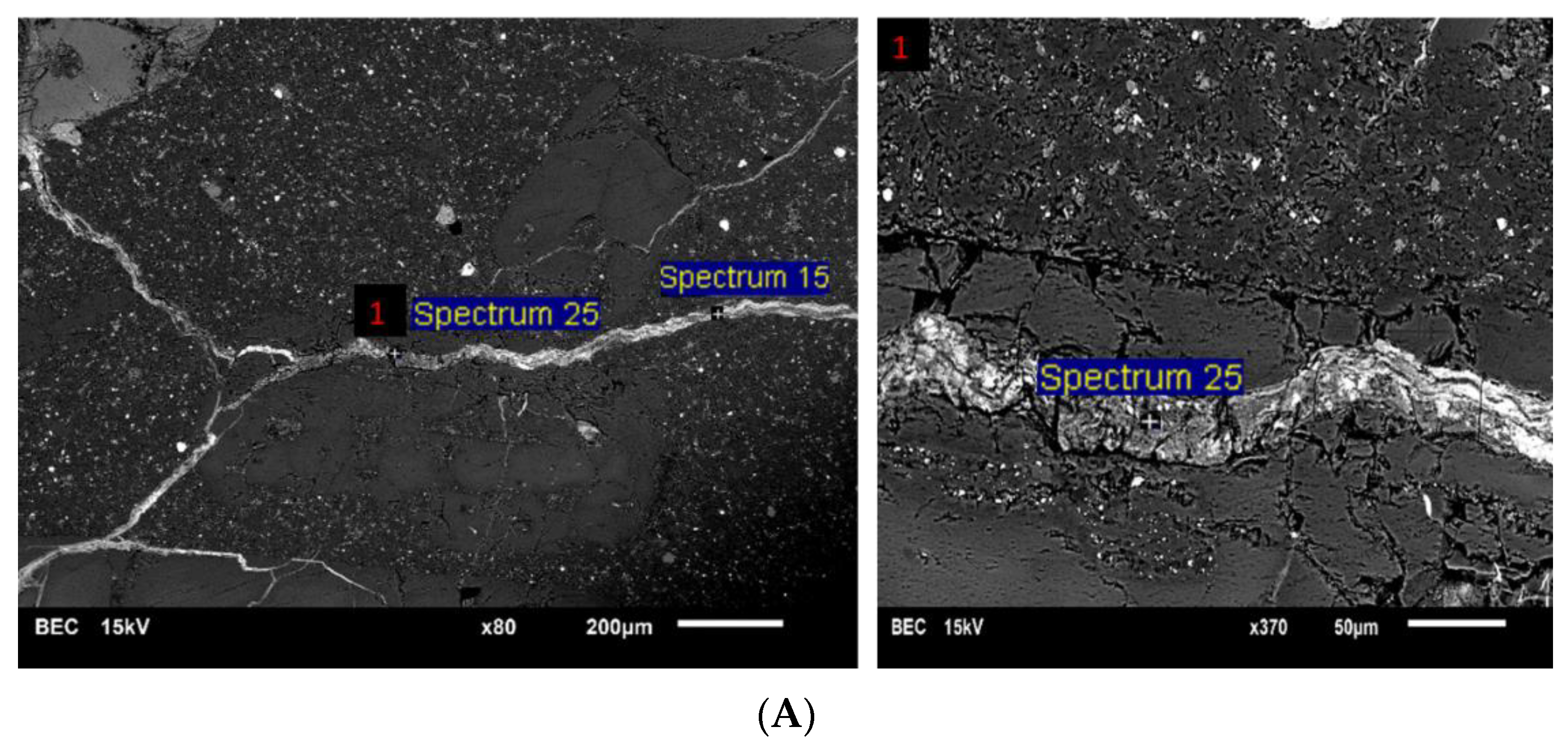
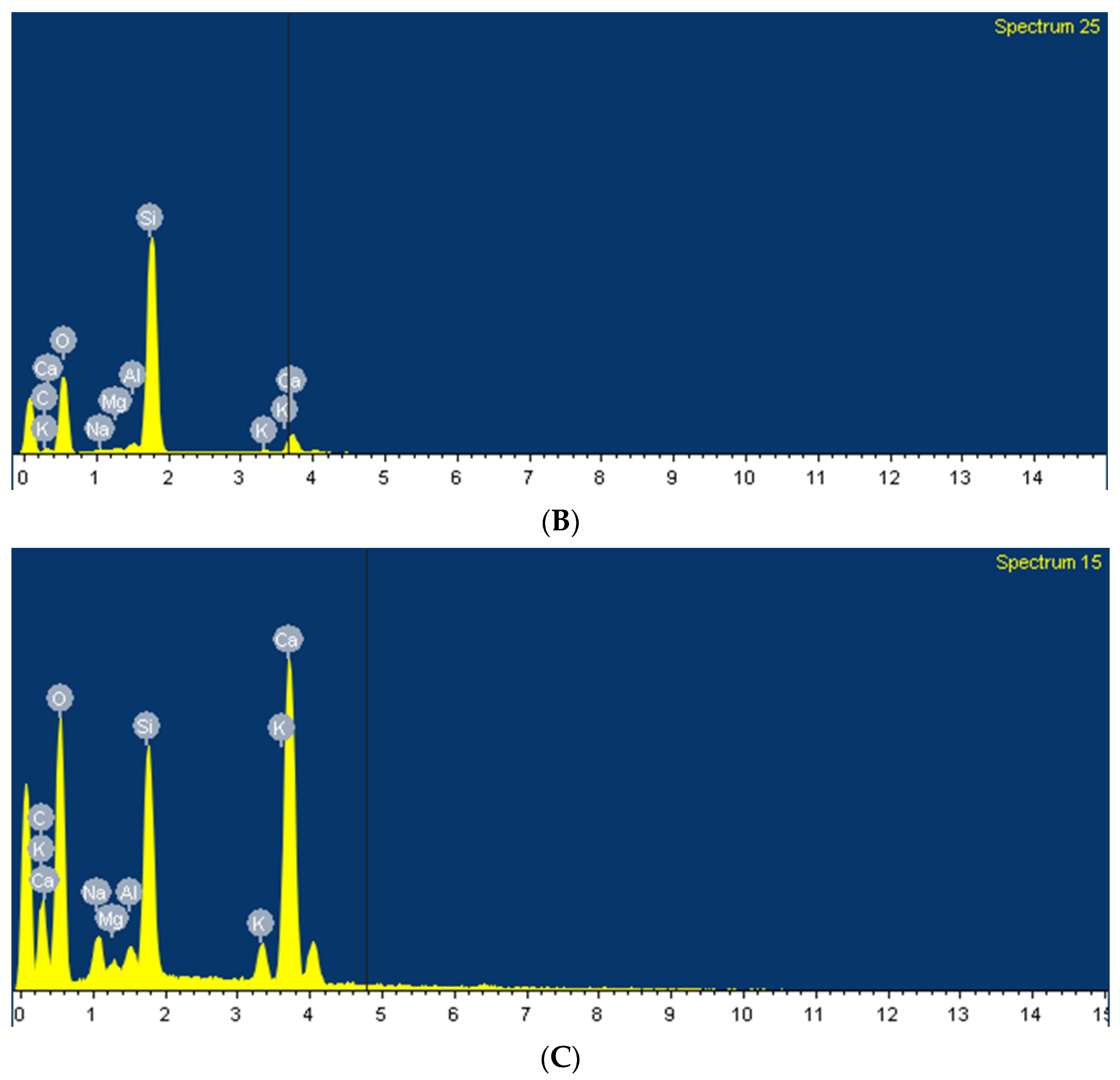
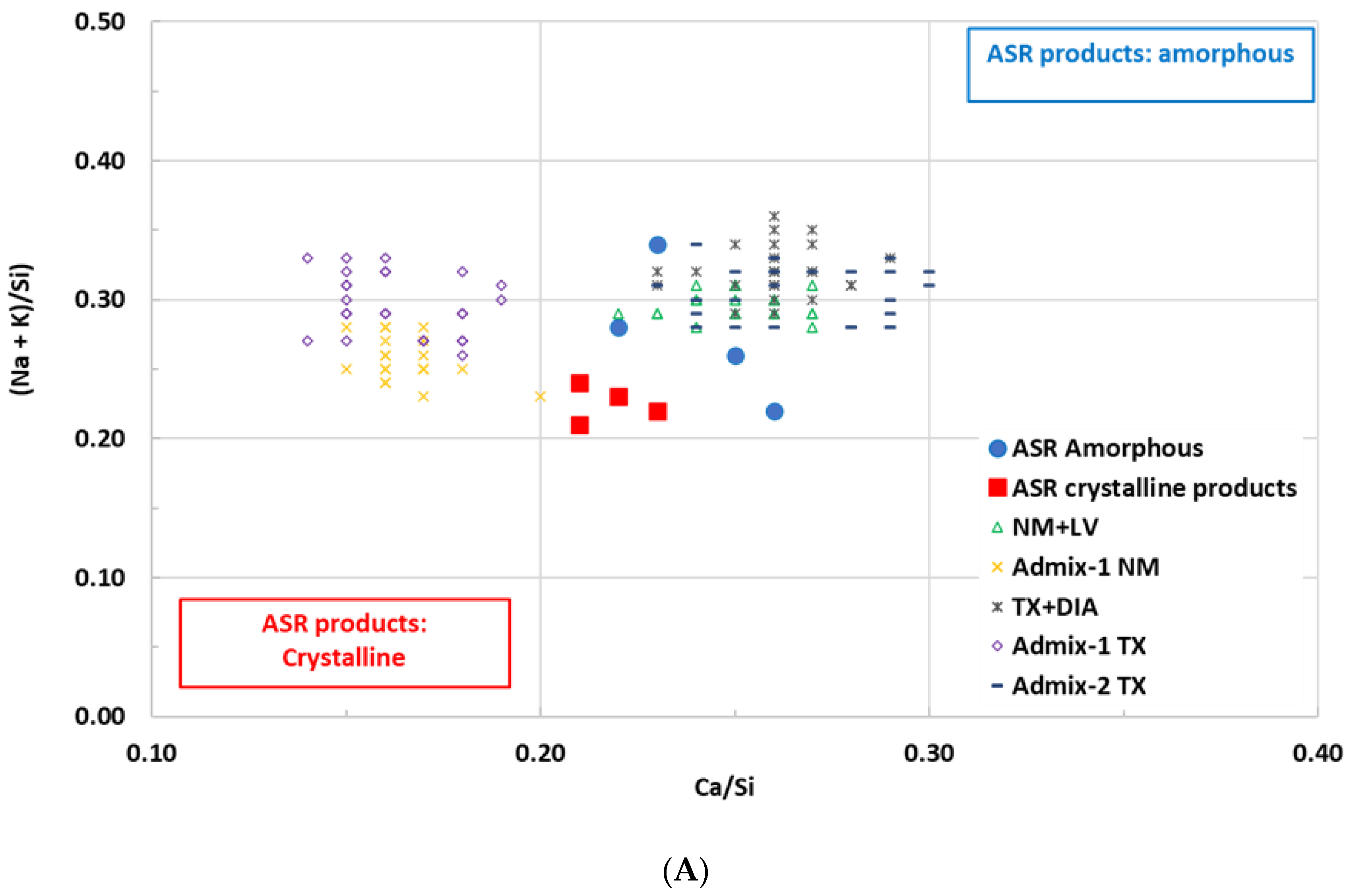

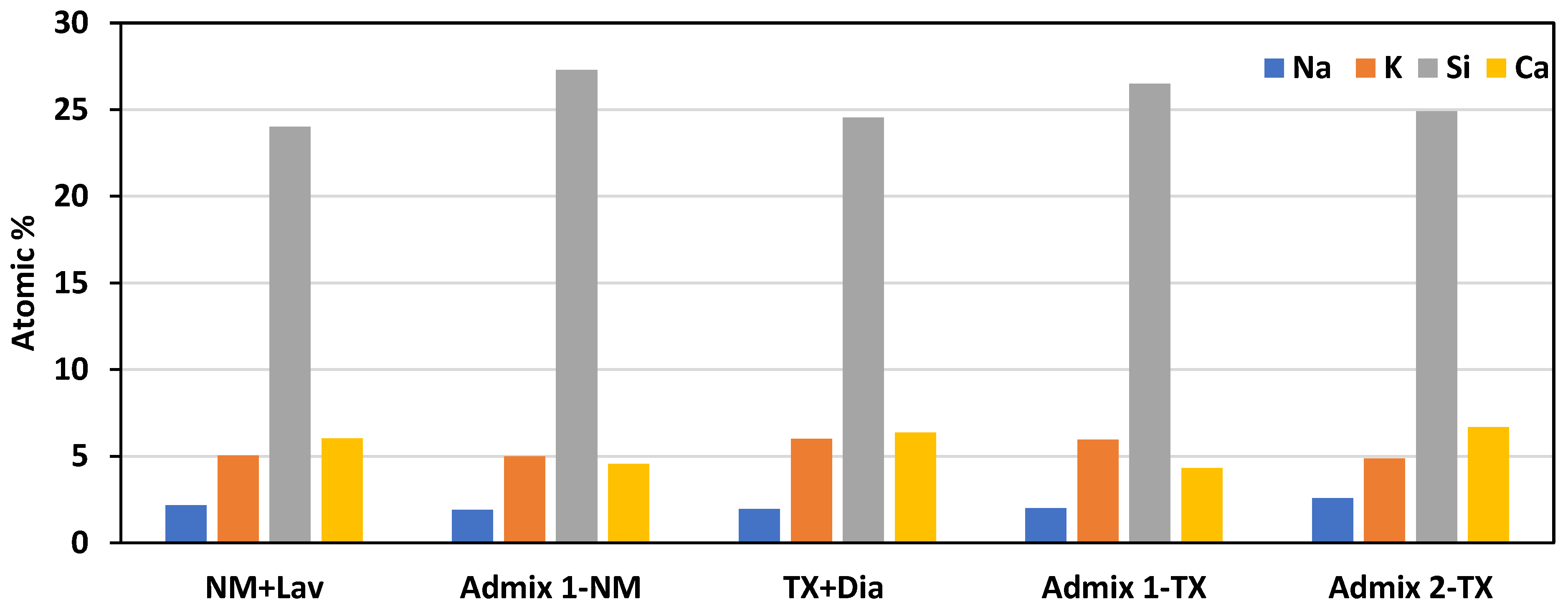

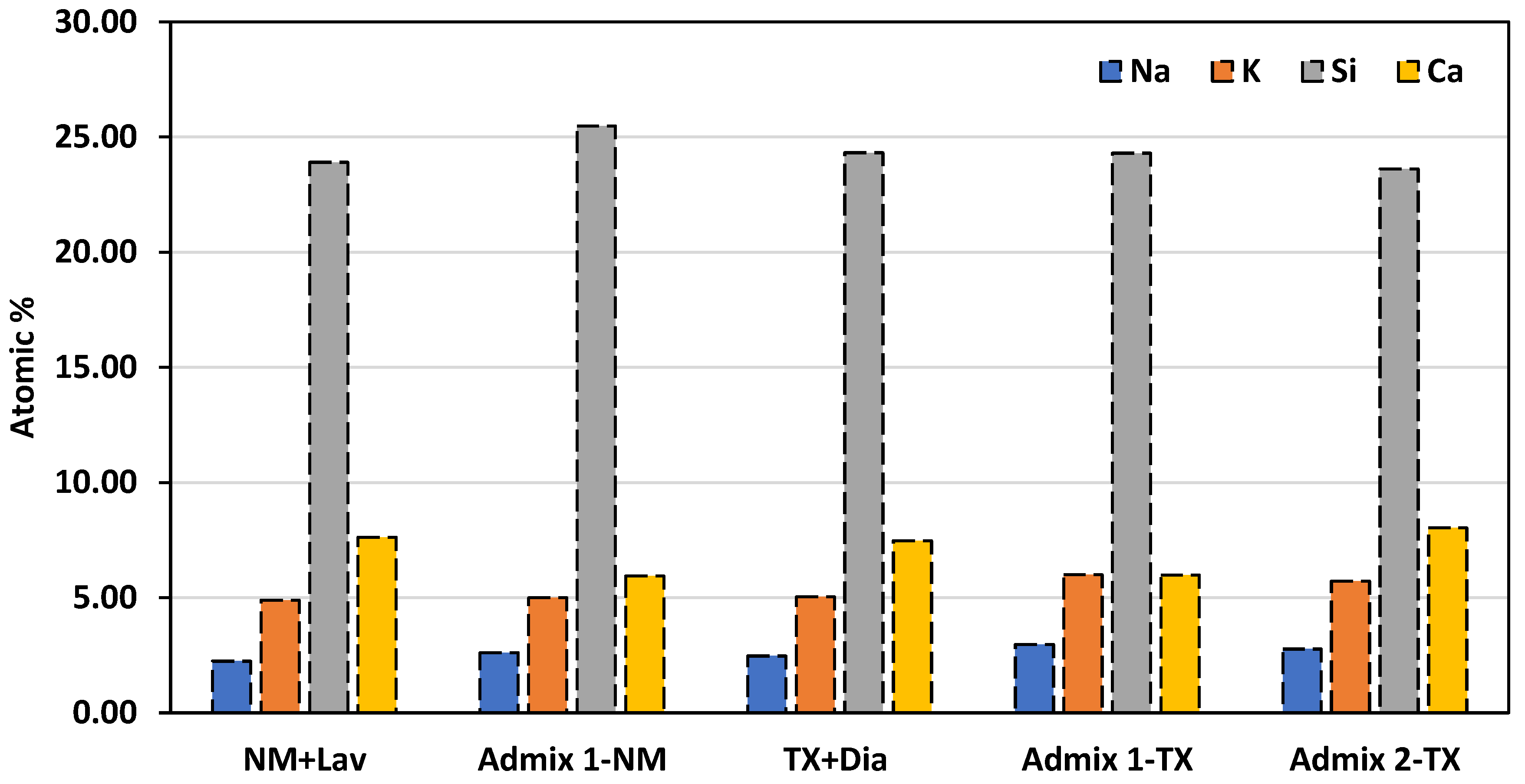
| Aggregate | Rock Type | Specific Gravity (g/cm3) | Absorption (%) | AMBT * (14 d exp) | |||
|---|---|---|---|---|---|---|---|
| Type | Reactivity | Location | Name | ||||
| Coarse | Reactive | New Mexico (USA) | NM | Polymictic gravel | 2.53 | 1.59 | 1.056% [54] |
| Nonreactive | Québec (Canada) | Dia | Diabase (plutonic rock) | 3.00 | 0.51 | 0.065% [6] | |
| Fine | Reactive | El Paso (USA) | TX | Polymictic sand | 2.60 | 0.55 | 0.755% [6] |
| Nonreactive | Laval (Canada) | Lv | Natural derived from granite | 2.71 | 0.54 | 0.068% [6] | |
| Name | Chemical Composition | pH | Standard Conformity | |||
|---|---|---|---|---|---|---|
| Na | K | Na2Oeq | Cl | |||
| Admixture 1 | 0.8 ppm (0.00008%) | 0.2 ppm (0.00002%) | 0.9 ppm (0.00009%) | 1.6 ppm (0.00016%) | 6.5 | ASTM C 494, Types F |
| Admixture 2 | 4.1 ± 0.1%. | 0% | 4.1 ± 0.1%. | <0.1% | 7.5 | ASTM C 494, Types A & F |
| Materials | Quantities (kg/m3) | ||||
|---|---|---|---|---|---|
| NM + Lav | Admix 1-NM | TX + Dia | Admix 1-TX | Admix 2-TX | |
| Cement | 424 | 424 | 424 | 424 | 424 |
| Fine aggregate (<4.75 mm) | 714 | 714 | 896 | 896 | 896 |
| Coarse aggregate (4.75–19 mm) | 1073 | 1073 | 1029 | 1029 | 1029 |
| Water | 157 | 157 | 157 | 157 | 157 |
| ANOVA Analysis | SDI | |||||||||||
|---|---|---|---|---|---|---|---|---|---|---|---|---|
| Specimens type | Load (%) | Expansion (%) | SDI-F | SDI-Fcritic | F > Fcritic | SDI_p value | α | p < α | ||||
| NM + Lav | 40 | 0.05–0.30% | 21.94 | 4.07 | ✓ | 0.000324 | 0.05 | ✓ | ||||
| Admix 1-NM | 40 | 0.05–0.30% | 39.50 | 4.07 | ✓ | 3.84 × 10−5 | 0.05 | ✓ | ||||
| TX + Dia | 40 | 0.05–0.30% | 19.13 | 4.07 | ✓ | 0.000523 | 0.05 | ✓ | ||||
| Admix 1-TX | 40 | 0.05–0.30% | 31.84 | 4.07 | ✓ | 8.5 × 10−5 | 0.05 | ✓ | ||||
| Admix 2-TX | 40 | 0.05–0.30% | 35.87 | 4.07 | ✓ | 5.49 × 10−5 | 0.05 | ✓ | ||||
| ANOVA analysis | PDI | ME | ||||||||||
| Specimens type | PDI-F | PDI-Fcritic | F > Fcritic | PDI_p value | α | p < α | ME-F | ME-Fcritic | F > Fcritic | ME_p value | α | p < α |
| NM + Lav | 25.31 | 4.07 | ✓ | 0.000195 | 0.05 | ✓ | 67.49 | 4.07 | ✓ | 5.06 × 10−6 | 0.05 | ✓ |
| Admix 1-NM | 11.27 | 4.07 | ✓ | 0.003038 | 0.05 | ✓ | 38.70 | 4.07 | ✓ | 4.14 × 10−5 | 0.05 | ✓ |
| TX + Dia | 14.04 | 4.07 | ✓ | 0.001493 | 0.05 | ✓ | 53.76 | 4.07 | ✓ | 1.2 × 10−5 | 0.05 | ✓ |
| Admix 1-TX | 6.85 | 4.07 | ✓ | 0.013342 | 0.05 | ✓ | 62.91 | 4.07 | ✓ | 6.62 × 10−6 | 0.05 | ✓ |
| Admix 2-TX | 67.89 | 4.07 | ✓ | 4.95 × 10−6 | 0.05 | ✓ | 40.28 | 4.07 | ✓ | 3.57 × 10−5 | 0.05 | ✓ |
| Classification of ASR Damage Degree (%) | Reference Expansion Level (%) | Assessment of ASR | ||||||||
|---|---|---|---|---|---|---|---|---|---|---|
| Conventional Concrete | Concrete Specimens Incorporating SP with Low Alkali | Concrete Specimens Incorporating SP with High Alkali | ||||||||
| ME Loss (%) | SDI | DRI | ME Loss (%) | SDI | DRI | ME Loss (%) | SDI | DRI | ||
| Negligible | 0.00–0.03 | - | 0.06–0.16 | 100–155 | - | 0.08 | 130–140 | - | 0.08–0.09 | 130–145 |
| Marginal | 0.04 ± 0.01 | 5–37 | 0.11–0.25 | 210–400 | 30–38 | 0.15–0.21 | 300–315 | 38–41 | 0.20–0.22 | 320–335 |
| Moderate | 0.11 ± 0.01 | 20–50 | 0.15–0.31 | 330–500 | 39–45 | 0.16–0.22 | 370–450 | 45–50 | 0.23–0.24 | 390–405 |
| High | 0.20 ± 0.01 | 35–60 | 0.19–0.32 | 500–765 | 46–49 | 0.18–0.26 | 590–615 | 50–55 | 0.26–0.28 | 600–625 |
| Very high | 0.30 ± 0.01 | 40–67 | 0.22–0.36 | 600–925 | 50–57 | 0.24–0.29 | 680–690 | 60–65 | 0.30–0.32 | 700–720 |
| A | |||||||||||||
| Mixtures | Source of ASR Products | Elements in Atomic-% | Number of Points | ||||||||||
| Na | Mg | Si | S | K | Ca | O | Ca/Si | (Na + K)/Si | Na/Si | Na/K | |||
| NM + Lav | Aggregate particles | 2.17 ± 0.8 | 0.05 ± 0.02 | 24.01 ± 4.45 | 0.00 ± 0.00 | 5.04 ± 1.3 | 6.03 ± 1.6 | 61.15 ± 3.2 | 0.25 ± 0.02 | 0.30 ± 0.01 | 0.09 ± 0.02 | 0.43 ± 0.04 | 53 |
| Admix 1-NM | Aggregate particles | 1.90 ± 0.22 | 0.05 ± 0.05 | 27.30 ± 4.22 | 0.00 ± 0.00 | 4.99 ± 0.52 | 4.55 ± 1.11 | 61.09 ± 4.23 | 0.16 ± 0.02 | 0.25 ± 0.02 | 0.07 ± 0.02 | 0.38 ± 0.05 | 62 |
| TX + DIA | Aggregate particles | 1.96 ± 0.7 | 0.05 ± 0.01 | 24.55 ± 3.11 | 0.02 ± 0.01 | 6.01 ± 1.46 | 6.37 ± 1.02 | 60.01 ± 4.11 | 0.26 ± 0.12 | 0.32 ± 0.02 | 0.08 ± 0.01 | 0.32 ± 0.04 | 46 |
| Admix 1-TX | Aggregate particles | 2.01 ± 0.10 | 0.09 ± 0.05 | 26.50 ± 3.89 | 0.01 ± 0.01 | 5.95 ± 0.85 | 4.31 ± 1.20 | 60.18 ± 4.11 | 0.16 ± 0.02 | 0.30 ± 0.1 | 0.07 ± 0.02 | 0.33 ± 0.03 | 36 |
| Admix 2-TX | Aggregate particles | 2.57 ± 0.22 | 0.09 ± 0.07 | 24.90 ± 3.10 | 0.00 ± 0.00 | 4.88 ± 0.88 | 6.67 ± 1.10 | 60.01 ± 2.01 | 0.26 ± 0.05 | 0.30 ± 0.04 | 0.10 ± 0.7 | 0.52 ± 0.06 | 25 |
| B | |||||||||||||
| Mixtures | Source of ASR Products | Elements in Atomic-% | Number of Points | ||||||||||
| Na | Mg | Si | S | K | Ca | O | Ca/Si | (Na + K)/Si | Na/Si | Na/K | |||
| NM + Lav | Cement Paste | 2.24 ± 0.44 | 0.02 ± 0.01 | 23.901 ± 2.11 | 0.00 ± 0.01 | 4.89 ± 0.21 | 7.62 ± 0.6 | 61.07 ± 1.82 | 0.32 ± 0.21 | 0.29 ± 0.02 | 0.09 ± 0.01 | 0.45 ± 0.02 | 40 |
| Admix 1-NM | Cement Paste | 2.61 ± 0.21 | 0.03 ± 0.01 | 25.48 ± 2.36 | 0.02 ± 0.02 | 4.99 ± 0.44 | 5.94 ± 0.66 | 60.48 ± 2.85 | 0.23 ± 0.36 | 0.29 ± 0.01 | 0.10 ± 0.01 | 0.52 ± 0.01 | 40 |
| TX + DIA | Cement Paste | 2.47 ± 0.14 | 0.02 ± 0.01 | 24.32 ± 1.25 | 0.00 ± 0.01 | 5.03 ± 0.36 | 7.42 ± 0.54 | 60.52 ± 2.88 | 0.30 ± 0.36 | 0.30 ± 0.02 | 0.10 ± 0.01 | 0.49 ± 0.03 | 40 |
| Admix 1-TX | Cement Paste | 2.97 ± 0.14 | 0.02 ± 0.01 | 24.30 ± 2.11 | 0.00 ± 0.02 | 5.99 ± 0.44 | 5.98 ± 0.56 | 59.85 ± 2.10 | 0.24 ± 0.52 | 0.36 ± 0.02 | 0.12 ± 0.02 | 0.49 ± 0.02 | 30 |
| Admix 2-TX | Cement Paste | 2.77 ± 0.66 | 0.03 ± 0.01 | 23.61 ± 3.01 | 0.01 ± 0.01 | 5.72 ± 42 | 8.03 ± 0.42 | 59.52 ± 2.02 | 0.34 ± 0.14 | 0.35 ± 0.02 | 0.11 ± 0.02 | 0.48 ± 0.01 | 39 |
Disclaimer/Publisher’s Note: The statements, opinions and data contained in all publications are solely those of the individual author(s) and contributor(s) and not of MDPI and/or the editor(s). MDPI and/or the editor(s) disclaim responsibility for any injury to people or property resulting from any ideas, methods, instructions or products referred to in the content. |
© 2023 by the authors. Licensee MDPI, Basel, Switzerland. This article is an open access article distributed under the terms and conditions of the Creative Commons Attribution (CC BY) license (https://creativecommons.org/licenses/by/4.0/).
Share and Cite
Zahedi, A.; Trottier, C.; Zhu, Y.; Sanchez, L.F.M. The Impact of Distinct Superplasticizers on the Degradation of Concrete Affected by Alkali-Silica Reaction (ASR). Materials 2023, 16, 3374. https://doi.org/10.3390/ma16093374
Zahedi A, Trottier C, Zhu Y, Sanchez LFM. The Impact of Distinct Superplasticizers on the Degradation of Concrete Affected by Alkali-Silica Reaction (ASR). Materials. 2023; 16(9):3374. https://doi.org/10.3390/ma16093374
Chicago/Turabian StyleZahedi, Andisheh, Cassandra Trottier, Yufeng Zhu, and Leandro F. M. Sanchez. 2023. "The Impact of Distinct Superplasticizers on the Degradation of Concrete Affected by Alkali-Silica Reaction (ASR)" Materials 16, no. 9: 3374. https://doi.org/10.3390/ma16093374
APA StyleZahedi, A., Trottier, C., Zhu, Y., & Sanchez, L. F. M. (2023). The Impact of Distinct Superplasticizers on the Degradation of Concrete Affected by Alkali-Silica Reaction (ASR). Materials, 16(9), 3374. https://doi.org/10.3390/ma16093374







